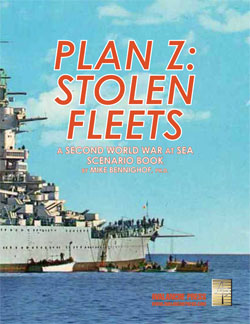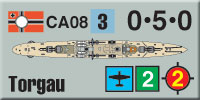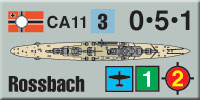| Stolen Fleets:
Captured French Heavy Cruisers
by Mike Bennighof, Ph.D.
February 2020
 France’s Marine Nationale emerged as the biggest loser of the 1922 Washington naval limitations talk. A European major power, victor of the Great War and possessor of a world-wide colonial empire, France was placed on a par with the despised Italians, with a ratio of capital ships a third that of Britain and only slightly more than half that of the Japanese. France’s Marine Nationale emerged as the biggest loser of the 1922 Washington naval limitations talk. A European major power, victor of the Great War and possessor of a world-wide colonial empire, France was placed on a par with the despised Italians, with a ratio of capital ships a third that of Britain and only slightly more than half that of the Japanese.
Economic devastation and exhaustion brought on by the Great War meant that the French Navy could not have built new battleships regardless of the treaty’s terms. As it was, to make their tonnage allotment they had to retain three useless pre-dreadnoughts of the Danton class. That did not keep the French admirals from grousing about their now-formalized second-tier status, but it did ease pressure on French politicians to spend non-existent funds on battleships.
Their hopes for a larger battle fleet thwarted, the Marine Nationale’s leadership turned to the so-called treaty cruiser. The Washington agreement put an upper limit for cruisers at 10,000 tons’ displacement and an armament of 8-inch (203mm) guns; anything larger in terms of size or weaponry would be considered a capital ship and count against the battleship total. The French team successfully warded off attempts to extend the battleship ratios to cruisers and submarines, and the Marine Nationale looked to build 21 of the ships to patrol the far-flung colonies and show the tricolor world-wide. Only seven of these ships would actually be built.
Four heavy cruisers were present at the November 1942 scuttling of the French fleet in Toulon, and in our Plan Z story they’re instead handed over to the Germans as part of the Armistice settlement. They serve under German colors in our Plan Z: Stolen Fleets. Let’s have a look at them.
The Second Class

The first French heavy cruisers, the two-ship Duquesne class, were interned in Alexandria in 1940 before joining the Free French naval forces in 1943. Among the first treaty cruisers laid down, They were not satisfactory fighting ships with weak protection, and the Marine Nationale considered converting them into light aircraft carriers.
The four ships of the follow-on Suffren class showed significant improvements. They had a thin belt; 50mm for the first two cruisers, increased to 60mm in the last of them. Like most treaty cruisers, they carried eight 8-inch (203mm) guns as their main armament, in four twin turrets. The French Model 1924 203mm gun was 50 calibers long, and armed all French heavy cruisers with a lightweight version mounted on the submarine cruiser Surcouf. The cruisers also carried six torpedo tubes, with a triple mount on either beam, with eight 90mm anti-aircraft guns and a rather small array of light anti-aircraft weapons.
The French laid down one ship per year between 1926 and 1929, and commissioned them between 1930 and 1932. The lead ship, Suffren, was interned in Alexandria in June 1940 and later joined the Free French forces. Colbert, Dupleix and Foch were all scuttled at Toulon.
In our alternative history, the cruisers aren’t scuttled in November 1942, but are instead handed over to the Germans without battle or sabotage damage. They still need refitting to ready them for German service, which they receive in Italian shipyards to avoid British attacks.
They retain their main armament; the French 203mm gun fired a shell with a heavier explosive charge than the equivalent German weapon, but with a significantly shorter range. But the German gun was 60 calibers long, and that would have made it a difficult fit in the French ships’ turrets. Their torpedo tubes are replaced with German models, and the 90mm anti-aircraft guns by German 88mm weapons. Their light anti-aircraft array is bolstered by more weapons.
After exercises and some operations alongside the Italian fleet, they re-deploy through the Strait of Gibraltar in 1944 to join the German fleet on the French Atlantic coast.
The Premier Treaty Cruiser

The appearance of the Italian Zara class with relative thick armor and the same armament and speed as Suffren deeply disappointed the Marine Nationale. The admirals demanded a similar ship for their next cruiser class, unaware that Zara achieved her fine qualities by displacing 11,500 tons rather than the stated (as agreed by treaty) 10,000 tons.
The naval architects delivered on that impossible task, as much as could be expected. Algérie would be the last French treaty cruiser, as new agreements capped the French total of such ships at seven. She could not match Zara’s armor thickness, but had a belt and decks nearly five times as thick as Suffren, plus excellent underwater protection. New, lighter turbines and a shorter hull helped keep her speed at 32 knots. She had the same main armament as Suffren (some sources say she had an improved Model 1931 203mm rifle, but this was only planned and the ship carried the older weapon). She did have new 100mm anti-aircraft guns in place of the older ship’s 90mm models.
Algérie saw limited action in the war’s first 10 months, but was not present at Mers-el-Kebir when the British attacked the French fleet. She went to Toulon, and was scuttled there with the rest of the French ships. Her crew then set her on fire and she burned for two days. She was cut apart by Italian salvage crews in March 1943.
In our Plan Z story line, Algérie is handed over to the Germans along with the other Toulon ships, and she joins the three Suffren-class cruisers at the La Spezia Naval Dockyard for refitting. The work required is minimal; replacement of her torpedo tubes and light anti-aircraft array with German models, new search radar, a new communications suite and German seaplanes.
Algérie had twice the range of previous French heavy cruisers, and slightly longer legs than the much larger German Admiral Hipper class heavy cruisers. She still could not match the reach of the German diesel-powered armored cruisers, designed for commerce raiding, but she had been built for Atlantic operations and would be very capable in an anti-shipping role. Renamed Rossbach in German service after Frederick the Great’s crushing 1757 victory over the French, the former Algérie is one of the most useful additions to the German Navy.
And those are the stolen French heavy cruisers of Stolen Fleets. Next time we’ll look at captured French light cruisers and aircraft carriers.
You can order Plan Z: Stolen Fleets right here.
Sign up for our newsletter right here. Your info will never be sold or transferred; we'll just use it to update you on new games and new offers.
Mike Bennighof is president of Avalanche Press and holds a doctorate in history from Emory University. A Fulbright Scholar and award-winning journalist, he has published over 100 books, games and articles on historical subjects.
He lives in Birmingham, Alabama with his wife, three children and his dog, Leopold.
|
